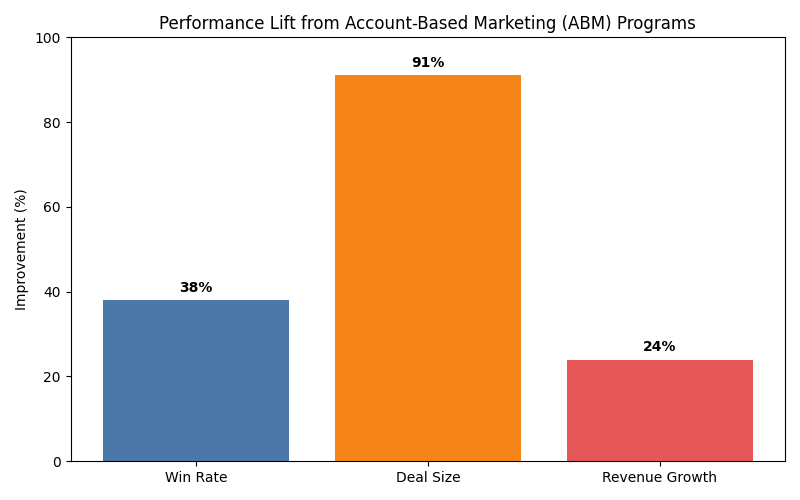How to Scale Personalisation in ABM Without Losing Focus?
Account‑based marketing (ABM) thrives on relevance. When marketing and sales teams target a handful of strategic accounts, they can invest time to understand each organisation’s unique pressures, align messages with its priorities, and build relationships that lead to revenue.
What happens when leaders ask for the same level of relevance across dozens or even hundreds of accounts? This blog article explores how to scale personalisation in ABM without turning your programme into a generic demand‑generation engine.
Personalisation at scale – The hardest part of ABM
ABM works because it treats each account as its own market. Companies running ABM programmes enjoy 38% higher win rates, 91% larger deal sizes, and 24% faster revenue growth than organisations relying on broad demand generation. These gains come from deep understanding and bespoke engagement. Unfortunately, that same depth makes ABM difficult to scale:
- High expectations: McKinsey found that 85% of consumers expect personalised experiences. B2B buyers carry the same expectation into their professional lives. When messaging lacks relevance, prospects tune out.
- Resource constraints: Many ABM teams hit a ceiling because their programs aren’t built to scale across dozens or hundreds of accounts. The other pressure comes from bandwidth. Most organisations simply don’t have the internal capacity to personalise at the depth ABM demands, so programs stall long before they reach maturity.
- Trade‑off between depth and reach: A SaaS company might achieve an outstanding 60% engagement rate by running 1:1 campaigns for 50 accounts. However, when it attempted to apply the same bespoke approach to 200 accounts, engagement plunged to 15% because the team was overwhelmed.
Marketing leaders face a dilemma: they know ABM delivers superior ROI, yet scaling it without sacrificing relevance seems impossible.
We will also unpack the systemic barriers to scale and show how technology, frameworks, and process design make it achievable.
What are the main barriers to scaling personalisation in ABM?
Scaling an ABM programme isn’t just a matter of adding more accounts. It requires a deliberate approach to data, content, technology, and measurement.
Five systemic challenges typically prevent marketing teams from taking ABM personalisation beyond a handful of accounts -
- Fragmented data - Personalisation is only as good as the data behind it. Intent signals, behavioural data, firmographics, and CRM records often live in separate systems. A visitor might be recognised by one tool but anonymous in another.
- Let's understand this with an example: a manufacturer that built dozens of personalised microsites experienced poor engagement because its targeting signals were rarely refreshed, leaving stale messages in front of dynamic buying committees.
- Over‑personalisation and relevance drift - In the rush to impress stakeholders, some teams over‑customise content. One‑to‑many ABM campaigns that merely swap prospect names quickly feel shallow and perform poorly. As programme scope increases, relevance often drifts; the experience becomes generic or, worse, irrelevant.
- The more teams scale with automation, the less authentic personalisation feels. Focusing on solving a business problem rather than simply inserting names prevents this drift.
- Content bottlenecks - ABM programmes require content tailored to different industries, pain points, personas, and stages. When the number of accounts expands from dozens to hundreds, creative teams struggle to keep up. Building modular content blocks and reusable templates solves this bottleneck.
- Technology misalignment - ABM success depends on orchestrating channels and data. When tools aren’t integrated, e.g., when an ABM platform can’t share audience segments with a marketing automation platform, messages get out of sync. Organisations with strong sales marketing alignment achieve 24% faster growth and 27% faster profit growth. Misalignment leads to lost momentum and inconsistent experiences.
- Measurement gaps - Many marketing teams still track leads, form fills, and impression counts. ABM requires a shift to account‑level engagement, pipeline influence, and revenue per targeted account. Without these metrics, marketers can’t see which personalisation efforts move deals forward. Prioritize accounts showing buying signals rather than casting a wider net. Measuring at the account level reveals where to intensify efforts or automate.
How can AI and automation help scale ABM personalisation intelligently?
Artificial intelligence (AI) and automation address many scaling challenges by unifying data, predicting intent, and personalising at speed.
The 2025 State of ABM survey reports that 84% of marketers leverage AI and intent data in their ABM campaigns, resulting in conversion lifts of 30% or more. Here are the most impactful ways AI and automation enable scalability without sacrificing authenticity.
Unifying intent, behavioural, and firmographic data
- Machine learning can unify fragmented data across browsing behaviour, content consumption, engagement signals, and firmographics.
- AI models turn these inputs into dynamic account scores that update as behaviour shifts. Predictive analytics uses historical patterns to forecast which accounts are most likely to convert.
- When these insights feed directly into the CRM and automation stack, teams can prioritise accounts with the highest buying probability and deploy resources more efficiently.
Automatic account scoring and content selection
Predictive scoring models rank accounts by potential value and likelihood to close. AI can then map content assets to each account’s stage and persona. Dynamic creative engines automate ad variations and landing page elements.
Natural‑language tools for message variation
AI can generate email subject lines, ad copy, and even microsite content that align with account context. Natural‑language processing models can generate persuasive variations while maintaining brand voice.
This helps teams avoid the “first‑name, company‑name” personalisation trap. Chatbots and conversational AI can recognise returning visitors and provide personalised recommendations based on previous interactions.
Real‑time automation across channels
Automation orchestrates the right message at the right time across email, advertising, web, and events. Multichannel orchestration platforms synchronise audiences and automate workflows across channels.
Let's consider a cybersecurity firm that used AI‑driven segmentation to run LinkedIn campaigns for 500 accounts; by dynamically inserting each account’s logo and personalising landing pages, it doubled engagement without adding manual work - demonstrating that automation reduces effort while increasing relevance.
AI and automation should augment human judgment, not replace it. Keep a human in the loop to maintain nuance.
What frameworks can CMOs use to keep ABM personalisation focused
To scale ABM without losing precision, CMOs need structured systems that balance depth and coverage. Three practical frameworks help teams maintain relevance at scale without overwhelming resources.
The 3 Tier ABM model
Not every account deserves the same level of personalisation. The tiered model below helps leaders allocate time, content, and team effort to deliver maximum commercial impact.
FTA Tiered ABM Allocation Model
(The following allocation ranges are FTA’s recommended starting point. Teams can tighten or loosen these bands based on deal size, sales cycle length and internal capacity.)

The graph above illustrates the positive impact of ABM on key metrics such as win rate, deal size, and revenue growth, reinforcing the blog’s emphasis on the value of personalization at scale. (Source: Salesforce Account-Based Marketing Guide)
This structure ensures top accounts receive depth while lower-tier accounts benefit from efficient personalisation driven by automation and modular content. It also prevents teams from over-personalising where the payoff is low.
The data-content-context framework
Scaling personalisation works only when three elements move in sync.
Data
Identify the right accounts and stakeholders using firmographics, technographics, intent patterns, and behavioural activity. AI models help unify these signals, score accounts, and predict buying readiness. Clean data flow becomes the foundation for every personalised touchpoint.
Content
Build modular libraries that can be assembled quickly for each tier.
This approach includes
- Base templates for common assets
- Interchangeable sections tailored by industry or use case
- Lightweight account-specific elements such as intros, pain points, or examples
This removes the need to create unique documents for every account while still delivering relevance.
Context
Deliver content at the precise moment and channel where it is most likely to influence a buying group. This includes coordinated email sequences, targeted ads, personalised landing pages, and tailored website experiences. When context is misaligned, even strong content fails.
When data, content, and context move together, every interaction feels intentional and aligned with the account’s journey stage.
Focus on the right metrics
Scaling personalisation requires a shift away from surface metrics toward account-level indicators that prove business impact.
- Engagement depth
Measure time spent, repeated visits, content paths and stakeholder involvement across the account. - Pipeline influence
Track how personalised journeys accelerate deal progression and shorten sales cycles. - Revenue per account
Assess the contribution of each targeted segment to closed revenue and lifetime value. ABM success is defined by depth, not volume.
An example: tiered ABM in practice
Let's consider an example - a fintech firm targeting 120 accounts initially treated all accounts equally and saw both engagement and team capacity suffer.
After adopting the tiered structure, it grouped accounts into 30 strategic, 60 target, and 30 scale. Manual research and executive outreach were reserved for the strategic tier. Industry-driven content frameworks powered the target tier. Programmatic personalisation handled the scale tier.
By aligning data, content, and context across all tiers and refreshing signals weekly, the company improved conversion rates by over 2x and doubled personalisation efficiency within 6 months.
How can teams operationalise personalisation without burning out?
Scaling ABM is ultimately a process challenge. The following practices ensure personalisation remains consistent and manageable -
- Centralise strategy and decentralise execution: Create a centre of excellence to define segmentation rules, content frameworks, and measurement standards. Execution can then be distributed across cross-functional pods, enabling faster decision-making and load sharing. Weekly signal reviews keep everyone aligned.
- Build reusable templates and modular content - Adopt a modular architecture that splits content into core templates, industry challenges, outcome narratives, and account-specific sections.
This reduces production time and ensures consistent quality across all tiers. - Use a shared dashboard: Combine CRM data, behavioural signals, engagement scores, and intent patterns into a single view.
This prevents blind spots and ensures sales and marketing teams prioritise the same accounts. - Define boundaries between personalisation and standardisation - Decide what must always be bespoke and what can follow dynamic rules.
Pain points and use cases may require manual depth, while CTAs or layouts can be automated. Clear boundaries prevent teams from over-personalising and reduce error rates. - Upskill teams on AI - Enable teams to use AI-driven segmentation, predictive scoring, and natural language tools.
This allows the same staff to manage larger account pools without additional headcount. Trained teams avoid tool fatigue and maintain consistency at scale.
Do you want more traffic?
.png)
Why Small Tasks Are the Next Big Revolution in Business Efficiency?
.jpeg)
How Creative Optimization Drives 40% More ROI in Performance Campaigns











